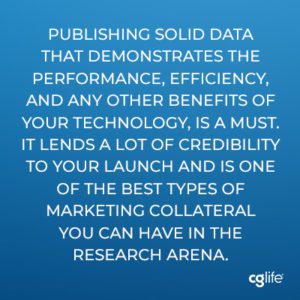

Marketing Lessons for Life Science Startups: Three Areas of Focus
Recently, I had the privilege of visiting the University of Illinois in Champaign-Urbana to speak to a group of young scientists in The Carl R. Woese Institute for Genomic Biology (IGB). This group of researchers had been selected by the Institute’s faculty to join the Professional Skills for Careers in Biosciences program and weren’t just passionate about their science, but also the world outside the lab. At its core, the group is redefining what it means to be a scientist, branching out into areas that include marketing and communications, and fostering skills such as professionalism, budgeting and leadership.
While at the IGB, it struck me that it had been nearly 13 years since I had made my own leap from the lab into the world of life science marketing, a world I had never considered as a possibility during all my years in research. Now, as a seasoned life science marketing professional, working at an agency, it made me happy to be returning to chat with a group of gifted scientists about some of the lessons I’ve picked up from my career transition.
One of the IGB’s central goals is to commercialize science, something I help clients do nearly every day. The goal of my talk, “Marketing Your Science,” was to present some best practices and practical tips for marketing and communications in the life science startup world. Together, we took a leisurely stroll (with some slight meandering) down the exhilarating road of the early-stage biotech company, with an emphasis on one key idea — focus. Below, I share my thoughts on where exactly to apply that focus.
Focus on R&D


I’ve helped develop a broad range of impactful marketing recommendations to our startup clients. At the foundation of our programs are the years of robust research and development they’ve put into developing your innovative technology. There is a lot we can do to market a “me too” product, but little to overcome poor or inconsistent performance of a product. For that reason, publishing solid data that demonstrates the performance, efficiency and any other benefits of your technology, is a must. It lends a lot of credibility to your launch and is one of the best types of marketing collateral you can have in the research arena.
Focus on Your Audience
The best preparation for commercialization is good, old fashioned market research. And if you haven’t gotten around to it yet, it’s never too late to start gathering data. Having regular discussions with your prospective customers can give you a deeper and more realistic understanding of their:
- goals and desires
- struggles and pain points
- current workflow
- what keeps them up at night


Even large companies struggle to communicate effectively to all of their audiences, so focus on the core segments that have the highest probability of getting your brand off the ground. It can be really difficult to let go of trying to please everyone, but by casting a wide net, you may end up missing the mark with all of your audiences. It’s also important to understand that there is more than one step that your audience takes when buying any product. It’s not simply about making the “decision” to buy. Don’t neglect the “awareness” and “consideration” stages of their journey. And if you do have a really innovative technology, you might have to spend a LOT of time in these early stages to educate your audience about the challenges you can help them solve.
Even large companies struggle to communicate effectively to all of their audiences, so focus on the core segments that have the highest probability of getting your brand off the ground. It can be really difficult to let go of trying to please everyone, but by casting a wide net, you may end up missing the mark with all of your audiences. It’s also important to understand that there is more than one step that your audience takes when buying any product. It’s not simply about making the “decision” to buy. Don’t neglect the “awareness” and “consideration” stages of their journey. And if you do have a really innovative technology, you might have to spend a LOT of time in these early stages to educate your audience about the challenges you can help them solve.
Focus on a Reasonable Communications Plan
There have never been more marketing channels and tools out there than there are today. And while each has its own benefits, it may not be smart to try them all. If you have a clear mission, a differentiated message and remain consistent, you won’t need to spread yourself too thin in the communications tactics you deploy. Working at an integrated marketing and communications agency, exposed me to the insane amount of ideas, opportunities, and capabilities we can employ for our clients. But just because you can, doesn’t mean you should. The key is prioritization. Focus on doing a few things consistently well, rather than jumping on every trend or offer that crosses your inbox. And be sure to set clear campaign goals and track your results. Marketing tactics these days offer analytics galore, so take advantage: It will help you measure ROI and tweak the program over time.
Talking to the IGB reminded me that the road to commercialize, for most scientists, is long and paved with challenges. Those challenges make focus an important part of the journey. I encourage you to keep at it! We’ve had the great honor of partnering with many incredible entrepreneurs, who don’t regret any of their experiences.
And if you’re looking for a partner that shares your commitment to focus, drop us a line.
